*All scripture citations are from the King James Version of the Bible.
The story of Christ’s birth is one that lives in the hearts of many people worldwide. With His humble beginnings, being born in a stable and laid in a manger, He is a source of hope, resilience, faith, and joy.
Matthew and Luke both tell this inspiring story, and both also detail Christ’s lineage. While the story of Christ’s birth resonates with many—evidence that God is there for us, even in the darkest times—the significance of Christ’s genealogy can sometimes be lost.
What was the genealogy of Jesus Christ, and why is it so important?
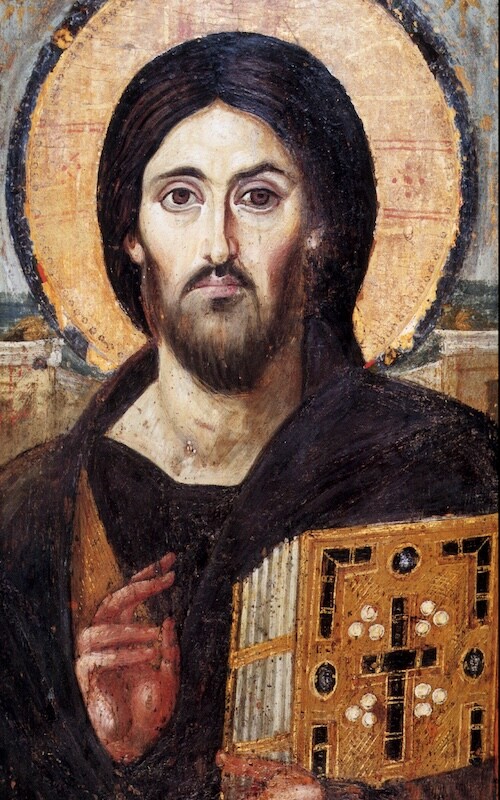
Why Is the Genealogy of Jesus Important?
Jesus Christ's family tree is listed twice in the New Testament. In the Old Testament, the Messiah is prophesied to be a descendant of Abraham, Isaac, Jacob, Judah, Jesse, and David. As Matthew and Luke detail Christ's family tree, they firmly link Him to these forefathers. By doing so, they affirm that Jesus is the Savior—that He fulfilled the messianic prophecies of the Old Testament.
Christ’s teachings on forgiveness, acceptance, and love; His parables of wisdom; His example of enduring in faith—all are part of His earthly mission and the fulfillment of Old Testament prophesy.
The Significance of Family History
Jesus Christ's genealogy does more than help establish His Messianic lineage in the fulfillment of prophecy. It grounds Him in human history, especially among other biblical stories. The generations between Jesus and David, Abraham, or Isaac create a sense of authenticity of time and space. They tangibly place Him in the mortal world.
Beyond that, the emphasis on Jesus Christ's family lines provides insight into Judaism and the rich heritage surrounding Christ. Ancestry is a prominent part of Jewish history, religion, and culture. A person’s place in society and his or her inheritance and belonging were all deeply linked to family heritage.
Your Family’s History
Just as Christ’s genealogy connects Him with the history and the stories of His ancestors, yours can connect you with your history as well—even if your family tree doesn’t fulfill prophecies in the same way His did. You don’t need to find a King David in your past to find meaningful stories that help you make sense of your family, your history, or your heritage. The very real lives of your ancestors can give you much personal insight.
What Is the Genealogy of Jesus Christ?
Matthew and Luke provide different accounts of Jesus Christ’s genealogy, tracing the line from Christ to Abraham and even to Adam. Luke starts with Jesus and moves toward the past, tracing His family from Joseph back to Adam. Matthew instead starts with Abraham and proceeds through generations, following the family line through to Jesus.
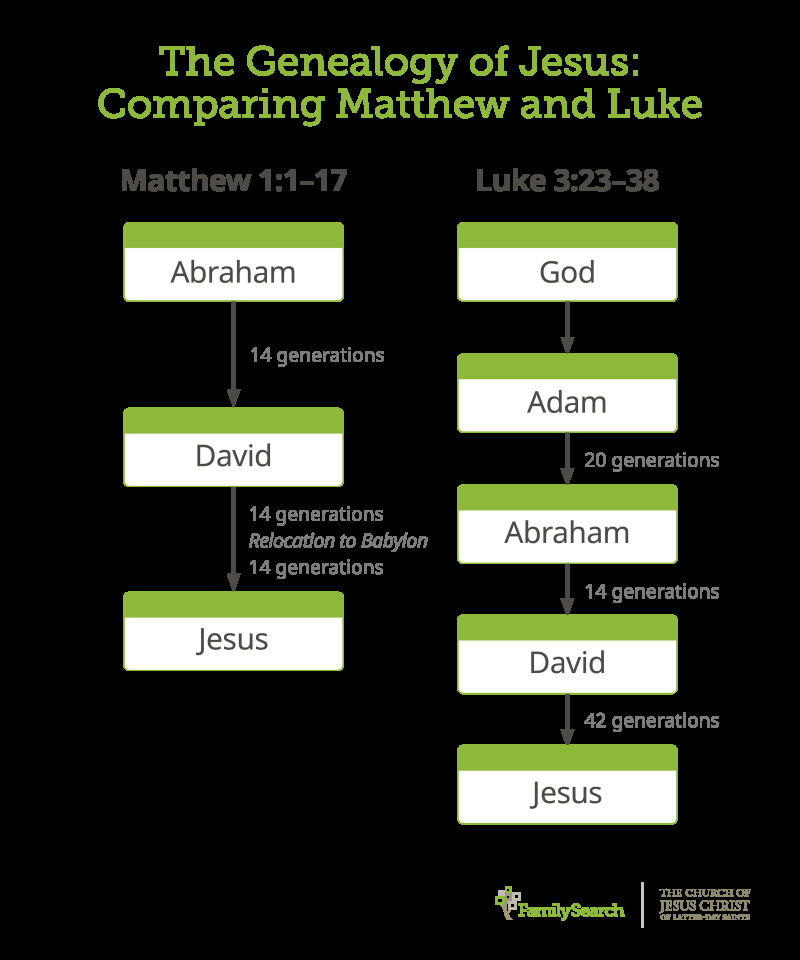
Matthew’s and Luke’s accounts have similarities, but there are also differences. From Abraham to David, they are identical. Both include 14 generations with the same ancestors.
After David, the genealogies branch. They each take the genealogy from a different son of David and mostly include differing names. Matthew’s version details 28 generations from David to Jesus, including 4 non-Israelite women, while Luke’s version has 42 generations in all.
Why Are the Genealogies of Jesus Christ Different?
To understand the differences between Matthew’s and Luke’s accounts of Jesus Christ’s genealogy, it’s important to understand the history, culture, and context surrounding the decisions these writers made. It is also likely that Jesus Christ’s descent can be traced through 2 of David’s family lines.
Matthew’s account was primarily intended for Jewish readers. Scholars believe Matthew focused on legal inheritance, which would also be the line used to trace kings and royalty. As a result, Matthew includes several adoptive names in his list. This approach presents the idea that Jesus Christ was the rightful heir of King David.
Matthew also chose to include generations in groups of 14. It was common in Hebrew genealogy to leave out some generations in favor of symbolic numbers. The same practice is seen in other books of the Bible. In Hebrew, each letter has a numerical value. The Hebrew letters of David’s name add up to 14, so the number 14 came to represent David’s line. By including 14 generations from Abraham to David and then 28 generations from David to Jesus, Matthew taught his Jewish audience that Christ was David’s legal descendant, thus claiming that He was the son of David prophesied in the Old Testament.
Luke took a different approach. He wrote a story for a wider audience that included Gentiles and Jews alike. He started with the story of how Christ was born. When he wrote the genealogy, he began with Christ and worked his way back not only to David and Abraham, but to Adam and God. Luke’s claim to the general populace was that Jesus is the Son of God, miraculously here as a Savior to all God's children.
Luke likely followed Jesus Christ’s natural, biological line. Scholars also suspect that Luke followed Mary’s family line, while Matthew followed Joseph’s family line. (Traditionally, people are considered Jewish if their mother is Jewish.)
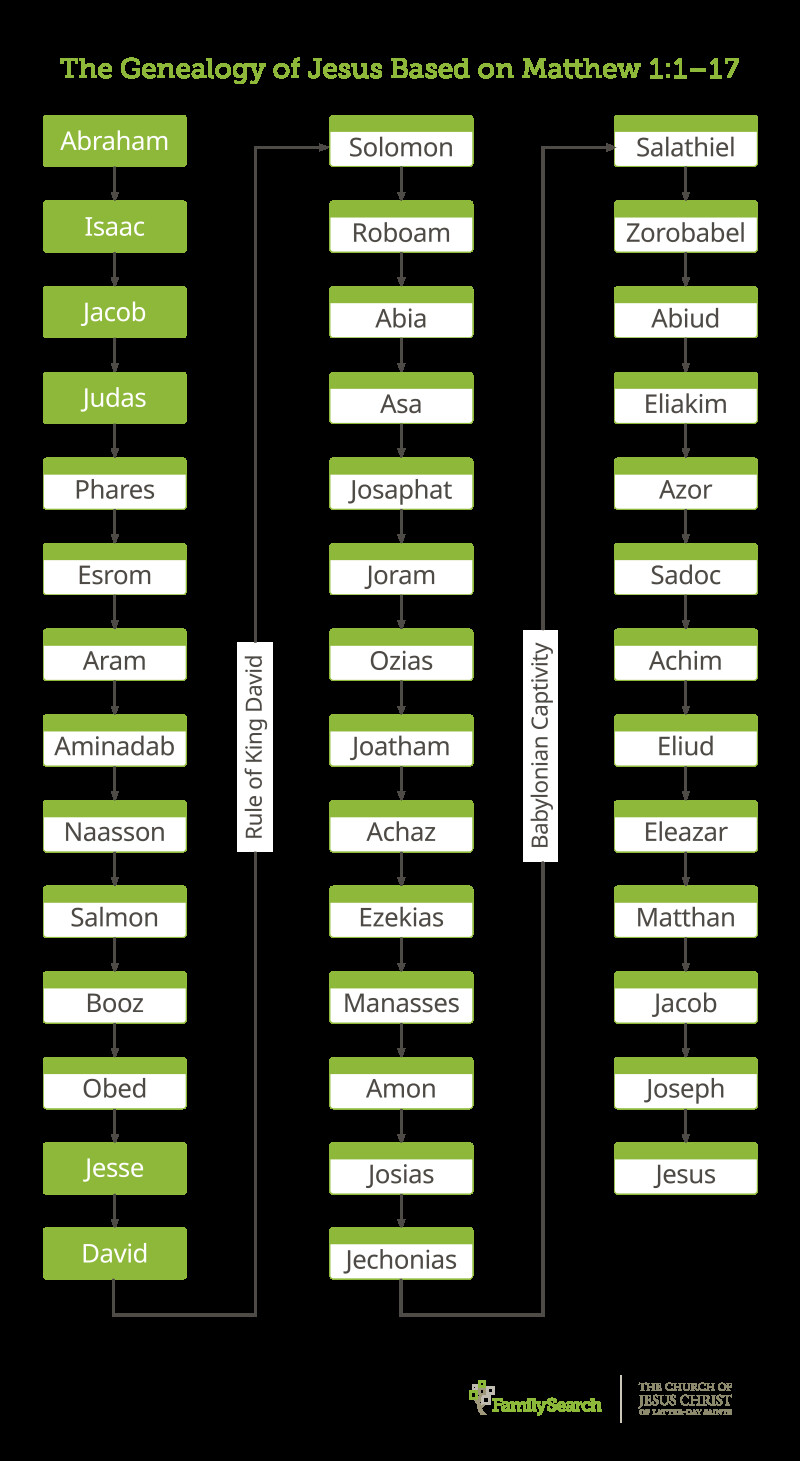
Matthew’s Genealogy from Abraham to Jesus Christ
Matthew traced Jesus’s family tree from Abraham to Jesus. This account of Jesus Christ’s genealogy includes several important figures in biblical history.
Luke’s Genealogy from Adam to Jesus Christ
Luke traced Christ’s ancestors back through the generations. He followed the family line to David, then to Abraham, and all the way to Adam. He made the final connection from Adam to God. Joseph Smith’s adjustments to the text might help explain why Luke’s genealogy is different from Matthew’s.
Bible scholar S. Kent Brown explained, “In an unusual adjustment, the Joseph Smith Translation renders . . . ‘which was the son of Heli,’ as 'who was from the loins of Heli’ (JST Luke 3:30). By contrast, in Matthew’s genealogy, Jacob, not Heli, is shown as the father of Joseph. Joseph Smith apparently suggests that Heli was a grandfather of Jesus. At the very least, Heli was a biological ancestor.”
Elder James E. Talmage further clarified the need for Joseph’s genealogy: “Luke’s record is regarded by many . . . as the pedigree of Mary, while Matthew’s is accepted as that of Joseph. The all important fact to be remembered is that the Child promised by Gabriel to Mary, the virginal bride of Joseph, would be born in the royal line.”
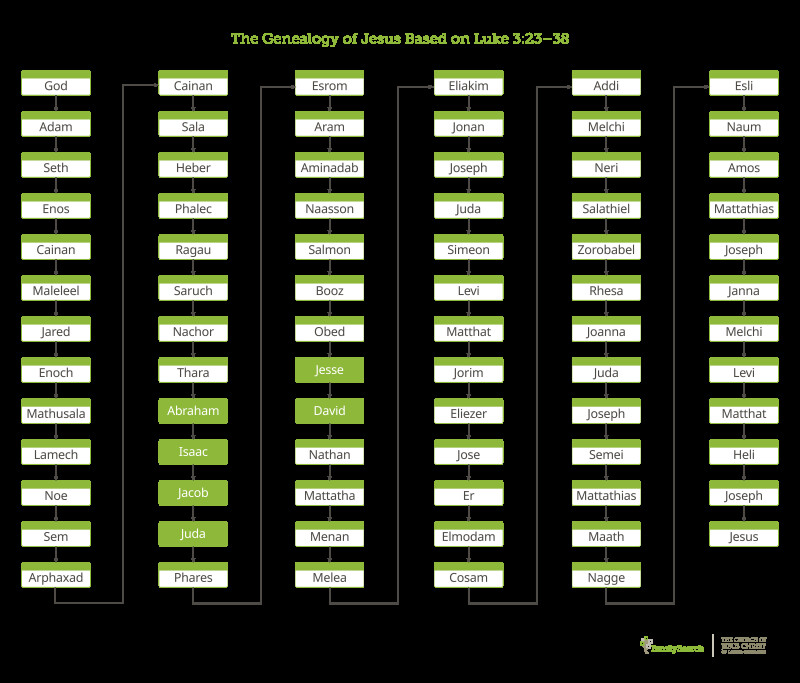
Where Is the Genealogy of Jesus Christ in the Bible?
Luke 3:23–38 and Matthew 1:1–17 both list the genealogy of Jesus. The book of Matthew introduces Christ as the Messiah through His genealogy. Matthew referenced the prophecies about Jesus Christ in the first verse by saying “the son of David, the son of Abraham” (Matthew 1:1). He beautifully set up the expectation that he was going to present the prophesied Messiah to his Jewish audience.
Luke, on the other hand, started with a story about a family. He told of Zacharias and Elizabeth, who were barren but were promised a son. And he related the miraculous story of Mary, who gave birth to the Son of God, despite being a virgin. Only after telling these stories did Luke share the genealogy of Jesus Christ in chapter 3. Luke’s message was geared toward Gentile and Jew alike.
Which Son of David Did Jesus Christ Descend From?
According to Luke’s account, Jesus descended from David’s son Nathan. Matthew instead listed David’s son Solomon as Jesus’s ancestor. A likely explanation is that Jesus Christ is descended from both Nathan and Solomon through different lines. Matthew possibly listed the legal ancestry (including adoptions) while Luke offered a biological ancestry.
- “And Jesse begat David the king; and David the king begat Solomon of her that had been the wife of Urias” (Matthew 1:6).
- “Which was the son of Nathan, which was the son of David” (Luke 3:31).
How Jesus Christ’s Genealogy Underscored Prophecies of the Messiah
Prophets in the Old Testament repeatedly told of the Messiah. They promised a Redeemer who would cleanse the world and bring joy to the nations. Prophets also made clear who the Messiah would be. They promised that the Savior would be a descendant of multiple prominent figures.
The Lord Promised a Savior Among Descendants
Several scriptures in the Old Testament predicted that the Savior would come as a descendant of specific people. Below are notable prophecies with at least one of the verses that make the promise.
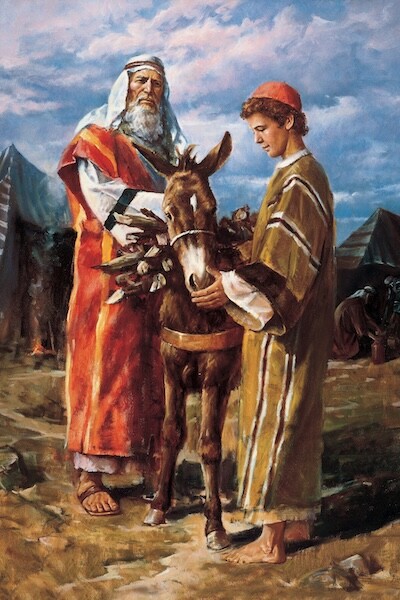
- Abraham’s seed will make a great nation.
In Genesis, the Lord promised Abraham, “And I will make of thee a great nation . . . and in thee shall all families of the earth be blessed. . . . Unto thy seed will I give this land” (Genesis 12:2–7). - Isaac will establish an everlasting covenant.
The Lord made another promise to Abraham. “Sarah thy wife shall bear thee a son indeed; and thou shalt call his name Isaac: and I will establish my covenant with him for an everlasting covenant, and with his seed after him” (Genesis 17:19). - The seed of Abraham, Isaac, and Jacob will bless the world.
The Lord repeated in near identical wording a promise to Abraham, Isaac, and Jacob, saying “And in thy seed shall all the nations [or families] of the earth be blessed” (Genesis 22:18, Genesis 26:4, and Genesis 28:14). - Shiloh will come from the tribe of Judah and gather the people.
While addressing his sons, Jacob said, “The sceptre shall not depart from Judah, nor a lawgiver from between his feet, until Shiloh come; and unto him shall the gathering of the people be” (Genesis 49:10). In this verse, “Shiloh” meant “the peaceful one.” - The Spirit of the Lord will rest on Jesse’s son.
Isaiah says, “And there shall come forth a rod out of the stem of Jesse, and a Branch shall grow out of his roots: And the spirit of the Lord shall rest upon him, the spirit of wisdom and understanding, the spirit of counsel and might, the spirit of knowledge and of the fear of the Lord” (Isaiah 11:1–2). - The Lord of Righteousness will be raised from David.
Several times throughout the Bible, the Lord promised that David’s seed would establish His kingdom. One such scripture reads, “I will raise unto David a righteous Branch, and a King shall reign and prosper, and shall execute judgment and justice in the earth . . . and this is his name whereby he shall be called, The Lord Our Righteousness” (Jeremiah 23:5–6).
Jesus Christ as the Fulfillment of Prophecies
According to both Luke and Matthew, Christ was a descendant of Abraham, Isaac, Jacob, Judah, Jesse, and David. The connection to these ancestors helped to confirm Jesus Christ as the Redeemer. In Matthew 1:1–17 and Luke 3:23–38, Matthew and Luke traced Jesus Christ’s genealogy, linking Him to each of these ancestors.
Why Were Mary and Joseph in Bethlehem?
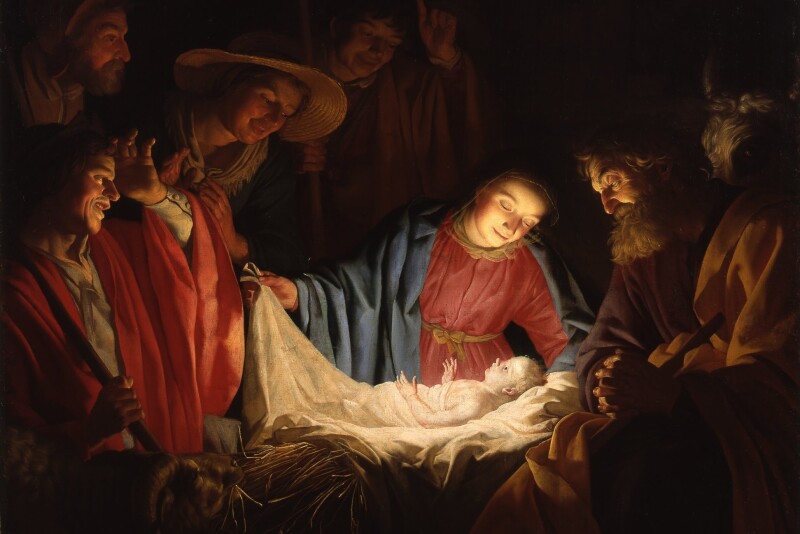
According to Luke 2, Mary and Joseph made their famous journey to Bethlehem to register in a census decreed by Cæsar Augustus. The decree called for the people to register in their “own city” for tax purposes. Mary and Joseph went to Bethlehem to register “because [Joseph] was of the house and lineage of David” (Luke 2:4).
Even though Joseph and Mary lived in Nazareth, Joseph may have originated from Bethlehem and later moved to Nazareth, or his family may have hailed from Bethlehem.
Bethlehem was then known as the city of David, and many of David’s descendants lived there. Joseph and Mary’s return to Bethlehem to register offered another clue to Christ’s ancestry. It fulfilled an additional prophecy—that the ruler of Israel would be born in Bethlehem.
“But thou, Beth-lehem Ephratah, though thou be little among the thousands of Judah, yet out of thee shall he come forth unto me that is to be ruler in Israel; whose goings forth have been from of old, from everlasting” (Micah 5:2).
Tracing Your Own Ancestry
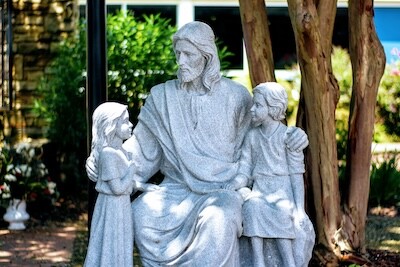
Many people hope to trace their family lines back to biblical figures, but no proven genealogies have been linked to the Bible. Family trees can be traced back generations, but at a certain point, records are impossible to verify.
Regardless of who you are, your ancestors paved the way for you to be here today. Their stories carry a rich history that is worth uncovering and that can help you understand more about yourself.
At FamilySearch, we care about connecting you with your family, and we provide fun discovery experiences and family history services for free. Why? Because we cherish families and believe that connecting generations can improve our lives now and forever. We are a nonprofit organization sponsored by The Church of Jesus Christ of Latter-day Saints. To learn more about our beliefs, click here.

